A parade where floats really float
December 7, 2011
Here in Southern California, we like to put our own stamp on the holidays. In a place where people can ice skate in tank tops and light up their palm trees with seasonal cheer, the Holiday Boat Parade in Marina Del Rey fits right in. Boat enthusiasts show holiday spirit by decking their ships, sailboats and yachts with lights and music.
“It’s like the Rose Parade on water,” said Debbie Talbot, who sits on the parade’s board of directors.
Still, like many legendary Angelenos, the Boat Parade comes from humble origins. It was first held in the 1960s when the marina had about a hundred boats and very few buildings. Now almost 6,000 boats are moored there and fireworks kick off the parade, which is narrated by local radio talent.
Last year’s theme was “rock ‘n roll.” A 34-foot Catalina sailboat outfitted with a 35-foot Elvis and illuminated by 32,000 lights took home top honors. This year’s theme is “Christmas Carnivale,” and more than 25 boats will compete for a variety of prizes.
To check out the free nautical fun, stake out a spot in Marina Del Rey on Saturday, December 10, before 5:55 p.m. (in time for the fireworks). The best viewing spots are Burton Chace Park at 13650 Mindanao Way and Fisherman’s Village at 13755 Fiji Way, according to Los Angeles County Department of Beaches and Harbors. Parking for the event is free at all County-managed lots.
Posted 12/7/11
The new kids on campus
December 1, 2011
 Throughout his 15 years, Mauricio hasn’t had much to celebrate, not with a turbulent family history that has led to a life of foster care and self-doubt. So when the call came, he couldn’t contain himself. “I was jumping up and down,” recalls the impish teenager.
Throughout his 15 years, Mauricio hasn’t had much to celebrate, not with a turbulent family history that has led to a life of foster care and self-doubt. So when the call came, he couldn’t contain himself. “I was jumping up and down,” recalls the impish teenager.
Mauricio had been informed that he’d been picked to participate in an unprecedented summer experiment on the UCLA campus, one that aims to infuse ambition and confidence into a group of kids who rarely go to college mostly because there’s been no one to help them get there.
Mauricio says he packed his suitcase a full month before the start of the intensive, five-week program and arrived so early on the first day that the former sorority house where he and the others would be living was still empty. “I was just so proud,” he says.
In a sense, however, the occasion represented more of a start than a finish. The students will continue to meet monthly on the Westwood campus and, if sufficient funds can be raised, will return in subsequent summers, along with new crops of recruits that will swell the program’s ranks and someday, hopefully, turn them all into full-fledged college students.
On Friday, that pride was shared by plenty of others—but, most importantly, by the 24 inaugural graduates of the First Star UCLA Guardian Scholars Summer Academy, the first such academic program of its kind for foster kids and others under the jurisdiction of child welfare officials. The youngsters, all of whom will be entering 9th grade, were honored during a commencement ceremony highlighted by one girl’s rousing exclamation: “I’m a Bruin now!”
In a sense, however, the occasion represented more of a start than a finish. The students will continue to meet monthly on the Westwood campus and, if sufficient funds can be raised, will return in subsequent summers, along with new crops of recruits that will swell the program’s ranks and someday, hopefully, turn them all into full-fledged college students. (Click here for a video on the program produced by Supervisor Yaroslavsky’s web staff.)
The program’s supporters say they’re determined to shatter the shameful statistics surrounding foster children, huge numbers of whom end up homeless and incarcerated in the years after their 18th birthdays, when they “age out” of the system. Only a fraction of them—an estimated two percent—continue their educations beyond high school.
“You can argue that college is their best possible ladder to leave behind a bad childhood and make it into a happy adulthood and a productive one that will not be a burden on the state, that will be something of high accomplishment,” says media executive Peter Samuelson, a driving force behind the program through his non-profit group First Star, which joined forces with UCLA and the County of Los Angeles.
“There’s nothing the matter with these children. Not one of them,” he says. “All of these kids can go to college. The issue is that nobody ever told them they could. How dumb is that? Who’s failing here, the kids or the grownups?”
The Summer Academy was designed to jump-start the participants’ collegiate careers and expose them to the rigors and culture of university life at a crucial juncture, just as they’re entering high school.
 Each earned four college credits through a challenging mix of classes tailored to their educational, psychological and recreational needs. Those included math, literacy, social media, tai chi, cooking and life skills, where they learned meditation and conflict resolution. In the evenings, they were visited by an impressive series of speakers, including National Hockey League great Luc Robitaille, whose Echoes of Hope charity targets the needs of at-risk Los Angeles foster youth.
Each earned four college credits through a challenging mix of classes tailored to their educational, psychological and recreational needs. Those included math, literacy, social media, tai chi, cooking and life skills, where they learned meditation and conflict resolution. In the evenings, they were visited by an impressive series of speakers, including National Hockey League great Luc Robitaille, whose Echoes of Hope charity targets the needs of at-risk Los Angeles foster youth.
And then there were the field trips to, among other places, Disneyland, Skid Row and celebrity Chef Mario Batali’s restaurant, Mozza, where one teenage girl sheepishly confessed to eating nine slices of the establishment’s famed pizza. (The Batali Foundation also contributed money to the Summer Academy, along with the Stuart Foundation, College Board, Sage Publications and Hasbro Children’s Foundation.)
“It scares you in the right way,” Tiffany, 14, says of the program’s morning-to-night regimen. “You know what you’re being pushed to do. A lot of people say, ‘Oh, I want to go to college.’ But until you actually see college kids and what they do and their level of intelligence, it’s hard to say yes.”
Initially, 30 students were selected for the program. But six boys were sent home in the second week for bad behavior, a wrenching decision for all involved. Still, academy officials had no intention of joining the long line of adults who’ve abandoned or given up on such boundary-pushing kids, a reflection of the program’s commitment to—and understanding of—its charges.
Program leaders have remained in contact with the remorseful teens and have held out the promise that they can participate in the group’s monthly UCLA gatherings and, if all goes well at home and in school, they’ll be able to join next summer’s class of young scholars.
“They’ve been told, ‘You are fine young men.’ They’ve all been given hope and a shining pathway of behavior to get themselves back in,” says Samuelson, who raised $305,000 for the summer academy. “When we get these six young men back into the academy, they will count amongst our greatest successes.”
Day to day, the program is run by a seemingly unflappable educator and former vice principal of an elementary school in a tough New Jersey neighborhood. “I fell in love working with students who felt that nobody else cared about them,” says academy director Wally Kappeler, 37, the father of an eight-week-old son.
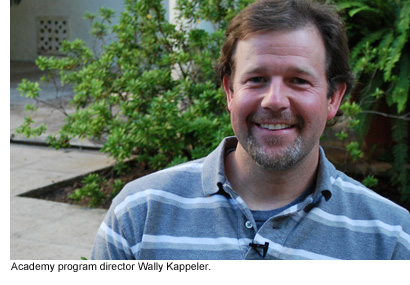 He says that, for him, the biggest surprise of the summer program was how quickly the kids were willing to open up, especially after an evening session when one of them broke the ice and shared the story of his mom’s death. “Here,” Kappeler says, “they have an opportunity to be heard.”
He says that, for him, the biggest surprise of the summer program was how quickly the kids were willing to open up, especially after an evening session when one of them broke the ice and shared the story of his mom’s death. “Here,” Kappeler says, “they have an opportunity to be heard.”
Kappeler says another boy, shy and self conscious about his weight, would mostly keep to himself like “an outcast” until he was given a special daily job of locking a rear door at their three-story Hilgard Avenue house after deliveries by the caterer.
“He felt so proud that this was his responsibility that he volunteered for all kinds of jobs,” Kappeler says. “He volunteered to take the trash out to the dumpster and wipe the tables and make Kool-Aid for the entire group. And it became contagious…It’s amazing the inspiration that he’s been to us, coming out of his shell and taking a leadership role without saying much of anything at all.”
Because of such breakthroughs and the upbeat bonding between the youngsters, it’s easy to forget the circumstances that brought them to UCLA—the abuse and neglect, the revolving placements in new homes and schools, the philosophies of life that have evolved from the sadness of their situations.
Listen, for example, to Eddie, a soft-spoken 15-year-old, who confides: “Too much happiness could actually hurt you. You just need the right amount because I don’t want to get hurt anymore. Right now I’m not really in the mood for situations like love and happiness. I really want to succeed in my life.” Eddie says he’s determined to be the first in his family to attend college.
Or hear what Thalia, 14, has to say as she speaks for the many who’ve been betrayed by parents. “Even if they’ve done something bad to you, they’re still your blood and they’re part of you and you love them no matter what. And you will always forgive them, even though you’re mad at them at the moment. But they’re always going to be in your heart.”
Kappeler says his heart aches when he hears the kids talk like this. “The emotional baggage they’re holding onto is the stuff that most adults would use as an excuse to give up on life.” Instead, Kappeler says the academy is teaching students to harness the power of their narratives through writing, video and social media so they can become more effective advocates for themselves.
“I want them to feel like they can make a difference in this world just by being who they are and getting their story out,” he says, noting that each was given a laptop and video flip-cam to keep.
To guide and inspire the participants along the way, the program was staffed by peer counselors and resident assistants who are UCLA students and, for the most part, former foster youths themselves.
One of was senior Julian Ramirez, 21. As a youngster in San Jose, he endured a home fraught with addiction and violence. “One day my dad would say, ‘Let’s go fishing.’ The next, he’d be beating us with the fishing poles.” Under a mop of dark hair, Ramirez says he’s still got a scar from a concrete slab his father smashed against his head. Child welfare authorities, he says, repeatedly removed him and his siblings from his parents.
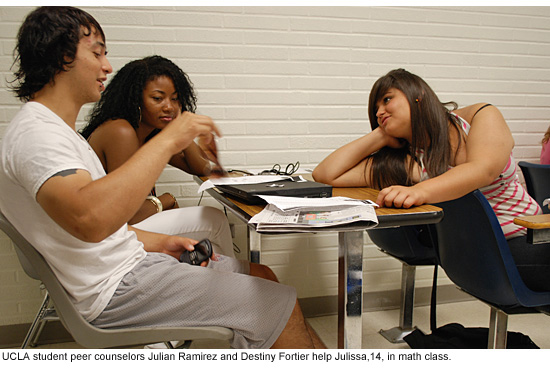 In his senior year of high school, Ramirez says it was “do or die” and he began to excel, achieving a 4.0 and becoming the captain of the wrestling team. He went to a community college in Cupertino—despite several months of homelessness—and then transferred to UCLA, where he joined the UCLA Bruin Guardian Scholars, a campus association of former foster youth. “What mattered to me most,” he says, “was that I wanted to stay on track with my peers. I didn’t want to be slower than them. And I wanted to prove to myself I was capable.”
In his senior year of high school, Ramirez says it was “do or die” and he began to excel, achieving a 4.0 and becoming the captain of the wrestling team. He went to a community college in Cupertino—despite several months of homelessness—and then transferred to UCLA, where he joined the UCLA Bruin Guardian Scholars, a campus association of former foster youth. “What mattered to me most,” he says, “was that I wanted to stay on track with my peers. I didn’t want to be slower than them. And I wanted to prove to myself I was capable.”
He says he hopes that his empathy and success—and that of the other student staffers—proved useful to the young teenagers in the summer program.
“I’ve been through a lot,” he says. “I know how it is to be 14, angry and not have anyone to talk to.”
In fact, the young participants told UCLA researchers late last week that the student mentors were “really impactful for them,” especially in the way “they talked about their journey through foster care,” says Associate Professor Todd Franke of the School of Public Affairs/Social Welfare, who’s conducting a longitudinal study of the students’ progress.
Franke says that, although it’s too soon to say much definitively about the program, there are some encouraging signs, based on a comparison of initial interviews with the teens and another series conducted on the eve of their commencement.
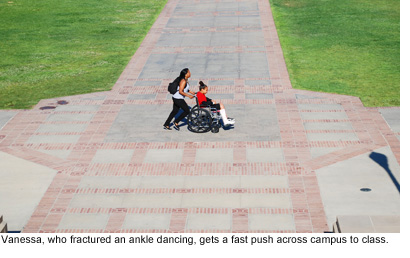 From the beginning, Franke says, virtually all the students said they wanted to go to college. “But in the past five weeks, the vast majority now see it as a much more realistic goal. It moved them further down the continuum to think that this is a real possibility for them.” They got a sense of the workload, learned that they’d likely be eligible for financial aid and came to believe that they’d have a strong campus support group to help get them through the rough patches, according to Franke. “The process,” he says, “was demystified.”
From the beginning, Franke says, virtually all the students said they wanted to go to college. “But in the past five weeks, the vast majority now see it as a much more realistic goal. It moved them further down the continuum to think that this is a real possibility for them.” They got a sense of the workload, learned that they’d likely be eligible for financial aid and came to believe that they’d have a strong campus support group to help get them through the rough patches, according to Franke. “The process,” he says, “was demystified.”
On Friday, commencement day, an assortment of foster parents, legal guardians and relatives gathered around dozens of tables inside UCLA’s Tom Bradley International Hall. There, they heard speeches about the heart and hope of the young Summer Academy participants. Among the officials who addressed the teens and their caregivers was Los Angeles County Supervisor Zev Yaroslavsky, whose office helped facilitate the program through the Department of Children and Family Services.
He told the teenagers that, on some level, he could identify with their struggles. He said his mother died when he was 10 and that his father worked in the evenings, which meant there was no one to help him with homework or keep an eye on him at night.
“The thing that you have that most college students don’t have is that by the time you get ready to come into college, you probably will have gone through the toughest part of your life,” said the supervisor, a UCLA alumnus. “And while you may not appreciate that, you should embrace that experience, treasure that experience, because it’s going to toughen you up. It’s going to make you tough enough to confront whatever comes along your way, when you’re in college and after that.”
After the speeches were done and the two-dozen scholars received their graduation certificates—along with a standing ovation—it was time for them to leave this place of grownup aspirations and youthful good times. There were lots of hugs and tears, even though they’ll all be together again on campus in a month.
“I feel proud but at the same time I feel sad,” explained Mauricio. “I feel like this is my house.”
Video and photos by Supervisor Yaroslavsky’s web staff.
Posted 8/7/11
A whirlwind of trouble
December 1, 2011
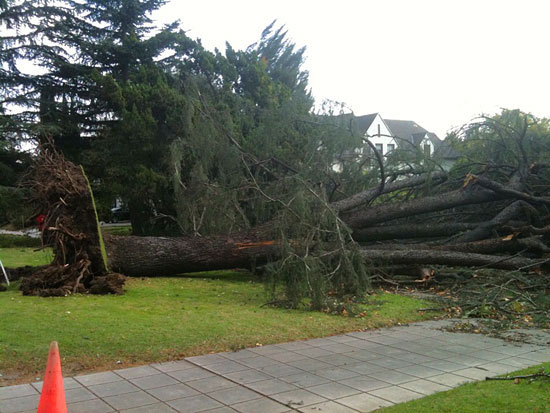
Two historic deodars were toppled in Los Feliz by windstorms. Photo courtesy of City Councilman Tom LaBonge.
For more than 75 years, majestic deodar cedars have lined Los Feliz Boulevard along Griffith Park. The imposing trees are an indelible part of the neighborhood’s character—and such a significant slice of the Los Angeles landscape that they’ve been granted cultural landmark status.
But no amount of civic protection could spare two of the beloved giants from the savage winds sweeping through the county this week. They were among hundreds of trees damaged or uprooted as gusts of wind approaching 100 miles an hour slammed Southern California, downing power lines and wreaking havoc including widespread outages, road closures and “wind days” in some local schools.
Much of the damage has been centered in San Gabriel Mountain foothill communities such as Pasadena, San Gabriel, Arcadia and Sierra Madre.
But the winds have left their mark on the Westside and the San Fernando Valley as well.
The toppled Los Feliz deodars, their massive roots completely unearthed, served as a powerful reminder of the winds’ damaging potential.
The trees, located in a stretch of some 200 deodars that together are classified as city Historical Cultural Landmark 67, were planted as part of a civic beautification movement in 1935.
The landmark designation means that they may not be pruned without official approval—but the winds did not play by the rules.
City Councilman Tom LaBonge, whose district is home to the trees, said the damage came as part of “the worst windstorm I have ever seen in the City of Los Angeles.”
“We don’t like to lose any of them,” said Donald Seligman, president of the Los Feliz Improvement Association, which maintains the trees. “They’re very unique for Los Angeles.”
With more high winds on the way, officials are urging extreme caution around power lines and trees. If you encounter a downed or dangling line, stay away from it and call 911 immediately. If you can, stay indoors, but don’t use the elevators, which could stall if there is a power outage.
To report damage to roads in unincorporated Los Angeles County, the number is 1-800-675-HELP (4357.)
More wind safety tips, from the Los Angeles City Fire Department, are here. And updated information on school closures, power outages and a recently-opened emergency shelter in Pasadena is here, along with a list of other helpful links.
Los Angeles County Supervisor Michael D. Antonovich, chair of the Board of Supervisors, declared a state of emergency in the county on Thursday afternoon, clearing the way for state and federal assistance. The cities of Pasadena, Sierra Madre and Monrovia also have declared local emergencies in the wake of the wind-borne devastation.
The urban forestry division of the city Department of Street Services was among the many agencies scrambling to stay on top of the damage Thursday morning.
“It’s pretty bad,” said chief forester George Gonzalez. “Calls are pouring in like crazy.”
Although the velocity is unusual, “wind events” typically happen three to five times a year in Los Angeles, Gonzalez said.
The ferocious Santa Ana winds are expected to continue today with gusts of up to 80 miles an hour in Southern California, the National Weather Service said. They’re part of a bigger storm that’s expected to affect the southwestern U.S. through at least Friday.
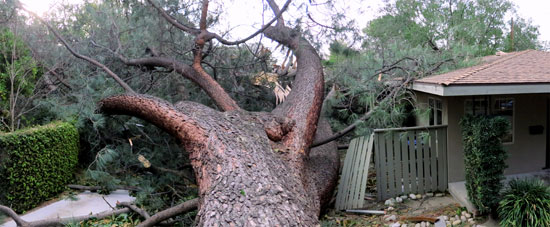
Nick Falacci took this picture of the huge tree that fell on his Pasadena house. No one was injured.
Posted 12/1/11
Getting creative with county bike plan
November 30, 2011
The wheels are in motion.
The county’s bicycle master plan—its first in 36 years—is about to get more innovative as it heads toward the finish line, Department of Public Works director Gail Farber said this week.
Responding to a unanimous push from the Board of Supervisors, the county’s bike planners will get to work on integrating more forward-looking design elements into the cycling master plan within the next 45 days, Farber said.
The board acted on a motion by Supervisor Zev Yaroslavsky which said the new bike plan should “not just move us out of the 1970’s, but move Los Angeles County forward as a leader in 21st Century bicyclist safety and comfort.”
To get there, the motion said the plan should incorporate “leading edge” designs such as those found in the Model Design Manual for Living Streets recently completed by the county Department of Public Health. Among the proposed innovations are varied lane and sidewalk widths, bolder paint treatments of bike lanes and “cycle tracks,” which separate bike lanes from traffic.
“The motion sends a clear message that the plan needs to do more to make the county a better and safer place to bike,” Farber said. “The board wants us to embrace these design concepts and we certainly plan to do so.”
Cycling advocates have been pressing for a bolder and more ambitious master plan, which will serve as a blueprint for bike facilities in unincorporated Los Angeles County for the next 20 years. The plan as currently drafted would add 816 miles of new bikeways over the next two decades, at a cost of $327.7 million.
The motion approved Tuesday represents a proactive approach to the bike plan, which must be approved by the county’s Regional Planning Commission before the Board of Supervisors formally takes it up early next year.
Testifying before the supervisors’ vote Tuesday was Alexis Lantz of the Los Angeles County Bicycle Coalition. She said the motion provided “guidance to staff” to create a plan that “truly improves the safety of our roadways, especially for people who need or choose to bicycle to meet their daily needs.”
A “visionary” bike plan could play a role in creating a healthier and more livable Los Angeles County over the next two decades, she said.
Farber said continued collaboration with the cycling community will be important as the plan moves forward. And she said she sees retooling the current draft as “more of an opportunity” than an obstacle.
“We’re excited,” Farber said. “We embrace the input.”
Posted 11/30/11
Sergeant to the stars calls it quits
November 30, 2011

Sgt. Steve Wheatcroft, escorting Lindsay Lohan into court last year, is no mystery man to those in the know. Photo/AP
The photo captions dub him the “unidentified man,” whether he’s escorting Lindsay Lohan through a blizzard of golden confetti or guiding Mel Gibson through a gauntlet of paparazzi.
But everybody who’s anybody in Los Angeles County courthouse and government circles knows that the tall, broad-shouldered figure in those pictures is Steve Wheatcroft.
The veteran county sheriff’s sergeant has long been an unsung but essential player on the front lines of L.A.’s celebrity-media circus, bringing decorum and safety to the courtroom comings and goings of America’s most photographed.
He’s been responsible for the security of judges like Lance Ito, who presided over O.J. Simpson’s murder trial. He’s made sure that defendants like Lohan, Gibson, Phil Spector and Dr. Conrad Murray made it through media scrums and into courtrooms with a minimum of chaos. And whenever a threat is made against a Los Angeles County judge or member of the Board of
Supervisors, Wheatcroft and his team have jumped into action.
But now, after more than two decades of rubbing shoulders with L.A.’s famous and infamous, Wheatcroft is ready for a little family time.
“As they always say at the Super Bowl, I’m going to Disneyland,” said Wheatcroft, 54, who will retire in the next few weeks after more than 32 years on the job.
Instead of heading up the sheriff’s Security Operations Unit—which assesses threats on public officials, helps manage high-profile trial logistics and provides protection to supervisors and judges—he’ll be hanging with his eight (soon to be nine) grandchildren and cruising around in his black ’59 Corvette.
Leaving the job is kind of like leaving the family business for Wheatcroft, whose brother and son also work for the sheriff’s department.
More than anything, he said, he’ll miss the camaraderie of the eight-member unit that he joined back when it was just a two-man operation run out of the county marshal’s office. When the marshal’s office merged with the Sheriff’s Department in 1994, Wheatcroft’s unit took over protective services for the supervisors as well as the judges. As part of the job, he has served as sergeant-at-arms for the Board of Supervisors’ meetings and helped with logistics for visiting dignitaries ranging from Muhammad Ali to Kirk Douglas.
At Tuesday’s board meeting, the supervisors gave Wheatcroft a big send-off.
“All I can say is this is the sweetest cop you will ever meet,” said Supervisor Gloria Molina. “But that doesn’t take away the kind of commanding presence that he has had here at the board.”
Supervisor Zev Yaroslavsky saluted his professionalism and ability to “defuse situations that could have gone the other way,” including threats made against the supervisor or his staff. “You put me and my family at ease during those moments,” Yaroslavsky told Wheatcroft.
Supervisor Michael D. Antonovich thanked Wheatcroft and also singled out his work in the courts. Ticking off a long list of celebrity defendants the sergeant has escorted, he noted: “You could see him in all the movie magazines.”
Which is true, actually, but doesn’t seem to have gone to his head.
Over the years, the “unidentified man” in all those photos has had the chance to observe a lot of famous people under difficult circumstances.
Lohan, Wheatcroft said, is “just kind of a confused girl” who told him she “likes to party.”
Nicest celeb? That would be Rod Stewart, whom Wheatcroft accompanied during a week-long civil proceeding at the courthouse. The British rocker was, in Wheatcroft’s words, “a humble, appreciative person.”
Close followers of the O.J. Simpson case may remember the time the jury, lawyers and judge in the so-called “trial of the century” took a field trip to Simpson’s Rockingham Avenue estate. Wheatcroft arranged it. He did the same with an excursion to Vitello’s restaurant during the Robert Blake case.
And—as if Los Angeles County didn’t have enough of its own well-known defendants—Wheatcroft has been called in to advise officials elsewhere in the U.S.and Canada on how to handle high-profile proceedings. He’s written on the subject in Officer magazine.
By his side throughout has been his high-school sweetheart and now-wife, Wanda. After the board send-off Tuesday, she said her husband had often shared tales from his star-studded work over the years.
“But only in an entertaining way,” she said, “never in a complaining way.”
Posted 11/30/11
Wood-burning fireplaces feel the heat
November 30, 2011
Chestnuts roasting on an open fire? Better check your woodpile and your air quality.
Amid concerns about agricultural pests and air pollution in Southern California, state and local authorities have been paying closer attention this year to wood-burning fireplaces, one the most fragrant, but environmentally vexing, aspects of winter in L.A.
For instance, the Southern California Air Quality Management District will begin issuing mandatory “no burn” advisories through the end of February on days in which fine particulates in the area exceed federal health standards. Though the advisories are expected to be rare, and first-time offenders can get off the hook by taking a smoke-awareness course, fireplace owners who repeatedly light fires on those days can be fined up to $500.
“Fine particulates are not only bad for the environment, but bad for our health,” says AQMD spokeswoman Tina Cherry. “They can lodge deep in your lungs and exacerbate lung conditions and asthma. So this year, on days when the fine particulate levels reach 35 micrograms per cubic meter, we’re asking people not to burn wood.”
State and agricultural authorities, meanwhile, have been urging residents with wood-burning fireplaces to “buy it where you burn it” when it comes to firewood because so many invasive insect pests and diseases are transported in woodpiles.
“Right now, there’s a quarantine in San Diego County because of a pest called the Goldspotted oak borer, which spreads via wood and is a real threat to oak trees,” says Frank McDonough, botanical information consultant at the Los Angeles County Arboretum & Botanic Garden.
“But you have to be careful even in areas without quarantines.”
The measures and warnings seek to wean Southern Californians from the wood fires that are such a tradition this time of year. To many, one of the coziest aspects of winter is the smell of a eucalyptus or oak log in the hearth, burning down to embers, but the fires that perfume winter nights with that smoky aroma also spew about 5.5 tons of particulate matter a day, on average, into the region’s air, according to the AQMD.
The new “no-burn” mandates are the latest in a set of measures aimed at controlling that pollution. Wood-burning fireplaces and stoves have been banned in new developments since 2009 in California, and voluntary no-burn days were initiated last year.
Although AQMD data has indicated that curtailment conditions can occur as often as 15 times in a typical winter, only one voluntary no-burn advisory was issued in 2010-11, and that was in February in the Riverside area, Cherry says.
This year’s mandatory no-burn laws will run from November 1 until February 29, and the AQMD will issue residential wood-burning advisories to let the public know whether particulate levels are elevated.
Residents can call a “Check Before You Burn” hotline at (866) 966-3293 to find out whether an advisory has been issued, or click here to sign up for an online notification. An interactive no-burn advisory map, which allows users to check for advisories by entering a ZIP code in the search area, is also available here.
Posted 11/30/11
Skid Row celebrates
November 30, 2011
On Saturday, the Skid Row Housing Trust is inviting neighborhood residents and the public at large to join together in a day of entertainment and interaction.
The group’s director of external affairs, Molly Rysman, says the event gives often-isolated individuals a chance to socialize.
“The goal is to help residents with community integration,” she says. “It’s an opportunity for people to come together and get to know their neighbors.”
Singer-songwriter Mary McBride will headline the event as part of “The Home Tour,” her series of charity performances in supported housing communities, long term health care centers, homeless shelters and other institutions. There’ll be other live musical acts, as well as karaoke, food and a fashion show.
Skid Row Housing Trust currently manages and operates 21 homes for the homeless of Los Angeles, providing a range of support services, including health care referrals and substance abuse treatment.
The organization also is a partner in Project 50, a Los Angeles County pilot program initiated by Supervisor Zev Yaroslavsky in 2007. The project originally targeted 50 individuals considered most likely to die on the streets of Skid Row. Using lessons learned from the pilot, the program has moved beyond the initial mission; to date, 92 chronically homeless people have been placed in permanent supportive housing through Project 50.
The block party takes place on Saturday, December 3, from 1 p.m. to 4 p.m., weather permitting. Parking is located at the Skid Row Housing Trust lot, 1326 Industrial Street. Please R.S.V.P. by calling (213) 683-0522, extension 159. The event is still seeking volunteers, too. If you want to pitch in, send an email to [email protected]. Of course, you can always support the organization’s ongoing efforts by donating online.
Posted 11/30/11
Pacoima on parade
November 30, 2011
As Southern California’s holiday parade season gears up, Pacoima is among the first to step out in style.
The 44th annual Pacoima Christmas Parade and Charity Toy Run begins at 9 a.m. on Saturday, December 3. The parade starts at the corner of Oneida Avenue and Van Nuys Boulevard, and travels east on Van Nuys to Glenoaks Boulevard. Local officials, celebrities and athletes are among this year’s participants.
At noon in David Gonzales Park there will be a post-parade festival, featuring local musicians, artists, performers and some of L.A. County’s ubiquitous gourmet food trucks. The festivities run until 4 p.m.
Posted 11/30/11
Bike plan push picks up speed
November 23, 2011
Los Angeles County’s new bicycle master plan, now in its final months of preparation, should be retooled to embrace more forward-looking design ideas and innovations for safer cycling on local streets, according to a motion set to go before the Board of Supervisors Tuesday.
The motion by Supervisor Zev Yaroslavsky calls on the county Department of Public Works to create a bike plan that “will not just move us out of the 1970’s, but move Los Angeles County forward as a leader in 21st Century bicyclist safety and comfort.”
Specifically, the motion says that the plan should “promote the use of leading-edge designs such as those found in the Model Design Manual for Living Streets that was prepared by the Department of Public Health.” Those include “cycle tracks” that separate bike lanes from traffic with dividers such as a lane of parked cars, and experimental street design approaches—including the possibility of varied lane and sidewalk widths in some areas—that do not fall within current Caltrans standards.
The motion urges the county to take the lead in helping such street layouts receive state approval for broader implementation.
If approved, the motion would not mandate such innovations at any particular locations, but would require that they be placed in the plan as options.
Many in the cycling community have been pushing for a bolder county bike plan, as was made clear by a series of bicycling advocates who appeared recently before the county’s Regional Planning Commission. The plan as currently envisioned would add 816 miles of new bikeways in unincorporated Los Angeles County over the next two decades, at a cost of $327.7 million. But many of those new miles fall into the lowest category of bike routes—those with just signage, no dedicated lanes or designated space within lanes.
The supervisors are expected to act on the bike plan, the county’s first since 1975, by March, 2012. But the motion makes it clear that changes need to be made before the plan’s final environmental impact report is finished in the days ahead.
“It is critical that the Board of Supervisors not wait to send a clear message that we expect this plan to do more to make the County a better, safer place to bike,” the motion said.
Posted 11/23/11





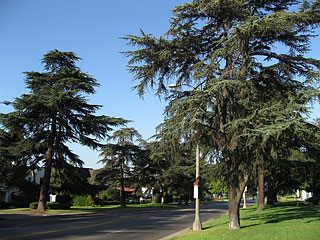
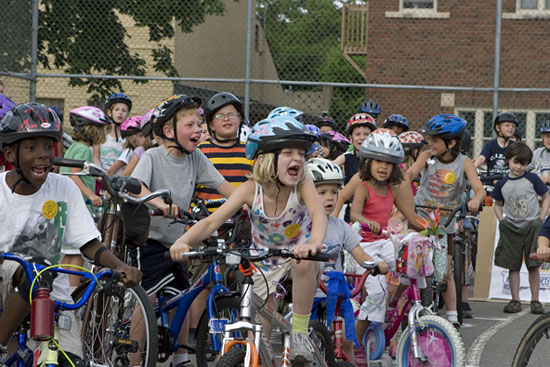
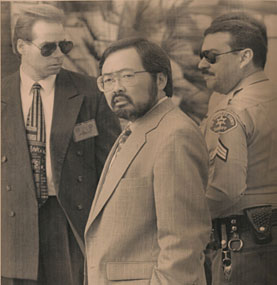

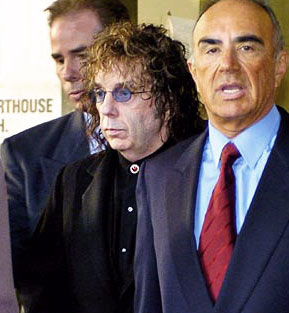
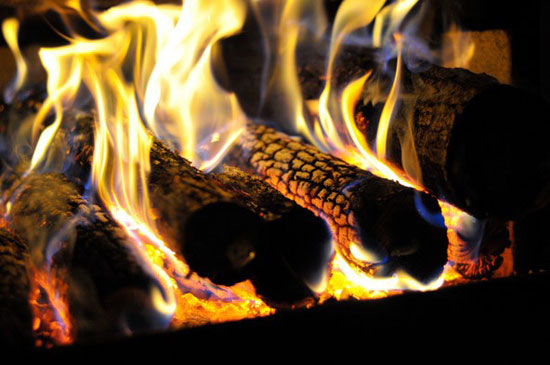

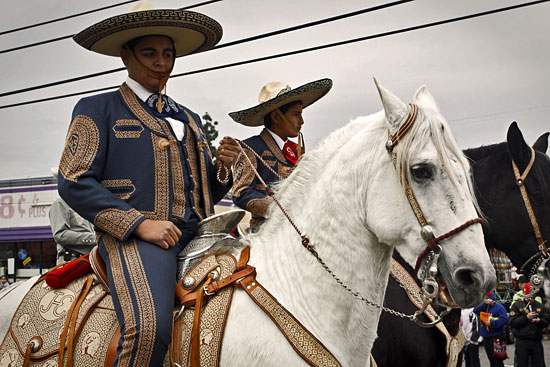
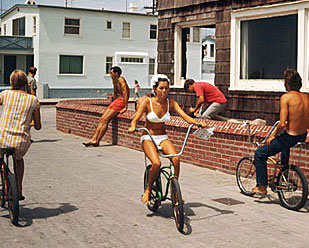





 Check for the latest closure information
Check for the latest closure information








